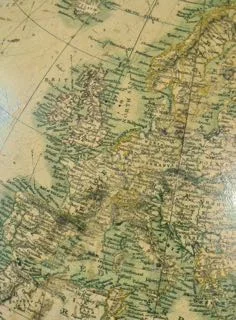Extremely scarce, very large Malby Terrestrial and Celestial Globe Pair with dated cartouche January 1, 1885 London




















Extremely scarce, very large Malby Terrestrial and Celestial Globe Pair with dated cartouche January 1, 1885 London
$0.00
The company Charles Malby & Co of London, later Malby & Son produced some of the finest globes from c 1840s to the end of the 19th century, after which Malby globes from Edward Stanford and others displaced. The 18 inch Globes were the largest in the "normal" range at Malby. Not many of these large globes had been produced, even less in pairs (terrestrial -celestial) as only the highest society had the wealth to afford such magnificent scientific instruments. Lordship desired ownership as these beautiful artifacts clearly displayed power, sophistication and knowledge.
One can say they still do so today.
Due to their rarity, these artifacts are seldom offered for sale or in auction. We have had not been able to document past auction results for the same pair . We did locate a similar single 18” terrestrial globe having sold for a bit over $13,000 (Christie’s 5428 – Travel, Science and Nature, April 23, 2008 South Kensington , London.)
Similar examples are to be found at the Mariners' Museum in Virginia: the celestial globe dated 1843 and the terrestrial globe dated 1846. The Austrian National Library has an 18 inch Malby terrestrial globe dated 1850, but we find no further example until 1872. The present 1885 examples we are offering appear to be unique. The Willis Museum in Basingstoke, England, and Dartmouth College in New Hampshire have examples of Malby's 18 inch celestial globes, but neither is accompanied by a terrestrial globe.
Description:
Each sphere consists of an 18inch diameter plaster orb, covered by twelve copper-plate printed, hand colored and hand applied paper gores and two polar calottes. Mounted into a numeric engraved brass meridian with hour dial atop. Sitting in a wooden cradle consisting of three baluster turned wooden legs and stretcher with cylindrical centerpiece and horizon ring. Total height is circa 25.5 inches.
Terrestrial:
Displays Imperial Empires of the past up to the most finest detail, including austro Hungarian, various German and British Empire to name a few. Dakota in the USa is not shown to be divided into North and South. Columbia is titled United States of Columbia with Panama still part of it. Many places in Africa are yet to be explored while others have become colonies of the Empires. Truly interesting history!
Celestial:
Showing various constellations and zodiacs, stars are identified by size. Beautiful, detailed copperplate etched details of characters and handsomely colored.
Condition:
Exceptionally well preserved, minimal wear in form of soiling or scuffing. Wear to the northern axis point of the terrestrial sphere in form of cracks. Please see photos, most significant wear shown in photos.
Brief history of the Globe Maker:
The Malby family of map and globe makers was started by Thomas Malby, Sr. about 1839 and continued producing globes until the turn of the 20th century. The firm operated as Malby & Son with Thomas Malby, Jr. and globes produced by the company generally were engraved by C. Malby -- presumably a family member -- and later continued by Thomas Malby III. The Malby firm is perhaps best known for producing a strikingly large reissue of John Addison’s 1825 terrestrial globe at about 36 inches in diameter (92 cm) produced for the Great Exhibition. Malby produced a variety of table globes in many sizes as well as an interesting pocket globe, with its largest production model being 18 inches in diameter. The depiction of the lines of magnetic variation on a globe was a Malby innovation. The Malby firm associated itself with the geographical publishing of the Society for the Diffusion of Useful Knowledge (SDUK). By 1862, Malby globes designed for the SDUK were published by Edward Stanford (1827-1904) whose company is still in business today. Malby also worked with James Wyld, a map, atlas, and globemaker. Wyld sold Malby globes with a James Wyld overlabel.
Ref:
Refer to Models of the world (page 286) and by Dekker van der Krogt (116 - 7) each terrestrial and celestial globe on the same stand. Cf. British Library on-line cat. BLL01013005847 (12 inch, 1869 & 18 inch, 1872); Dekker, GLB0081 (12 inch, 1845); Dunn & Wallis, British globes up to 1850 (1999) 209 (18 inch, 1846, 1 example) & 443 (18 inch celestial globe, 1848, 2 copies); KVK & WorldCat (18 inch, 1850 & 1872, 1 example of each); World in your hands (Rudolph Schmidt coll.) 7.12 & 7.13 (12 inch, 1843 & 1860); http:--www.nationaltrustcollections.org.uk-object-499558.2 (18 inch celestial globe, 1853); Yonge, Early globes (1968), p. 46 (18 inch, 1846, same example as Dunn & Wallis).
$17,000 SKU # P715MalbyPair
sold out
